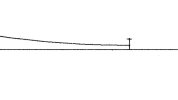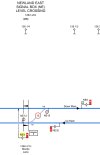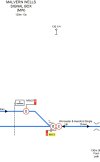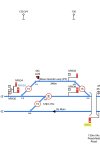Annetts key
Established Member
So, to clarify, before the standard changed (under BR sometime between 1988 and 1994 I think, but I can’t remember the actual year), FPL (facing point lock) equipment was only required for points that were facing for booked passenger train movements (as in trains actually advertised as passenger trains for passenger use).
All other points did not require FPL equipment. However, some point operating equipment (POE) (such as clamp locks - RCPL rail clamp point lock, have FPL equivalent equipment as standard).
So for points that were used in the facing direction, that were not FPL fitted, light locos, freight trains, engineering trains, inspection trains and empty passenger trains running as ECS (empty coaching stock), as well as on track machines could all use these points.
If an in service passenger train had to use points not provided with a FPL, then as described above, they would have to be fitted with a clip and a scotch. The same applies if a FPL or the POE has failed and detection cannot be given.
Why was this done? Because it was cheaper. Less equipment, less complexity equals less cost.
Since then, things have changed. Firstly there are less staff available to carry out point clipping and scotching, secondly the relative cost has changed (the cost of providing a FPL with current POE is insignificant as all modern power operated POE comes with a FPL as standard) and it’s operationally more flexible to have all points on main running lines provided with FPLs.
Different railway companies used different symbols on their various diagrams, some BR regions continued their own thing. For Western, normally on S&T diagrams (not signallers) an FPL is shown as below:

For signal box diagrams, either “FPL” and then the lever number was put on the diagram, or just the lever number for the FPL.
All other points did not require FPL equipment. However, some point operating equipment (POE) (such as clamp locks - RCPL rail clamp point lock, have FPL equivalent equipment as standard).
So for points that were used in the facing direction, that were not FPL fitted, light locos, freight trains, engineering trains, inspection trains and empty passenger trains running as ECS (empty coaching stock), as well as on track machines could all use these points.
If an in service passenger train had to use points not provided with a FPL, then as described above, they would have to be fitted with a clip and a scotch. The same applies if a FPL or the POE has failed and detection cannot be given.
Why was this done? Because it was cheaper. Less equipment, less complexity equals less cost.
Since then, things have changed. Firstly there are less staff available to carry out point clipping and scotching, secondly the relative cost has changed (the cost of providing a FPL with current POE is insignificant as all modern power operated POE comes with a FPL as standard) and it’s operationally more flexible to have all points on main running lines provided with FPLs.
Different railway companies used different symbols on their various diagrams, some BR regions continued their own thing. For Western, normally on S&T diagrams (not signallers) an FPL is shown as below:

For signal box diagrams, either “FPL” and then the lever number was put on the diagram, or just the lever number for the FPL.




